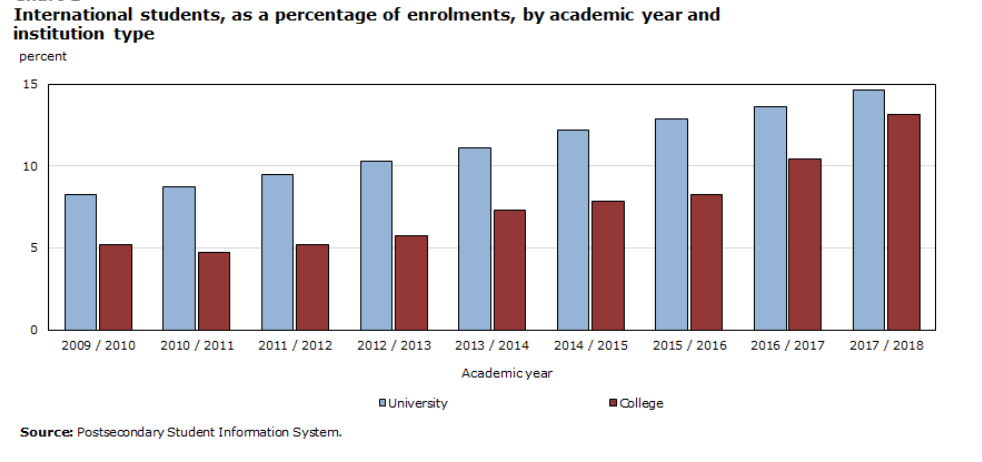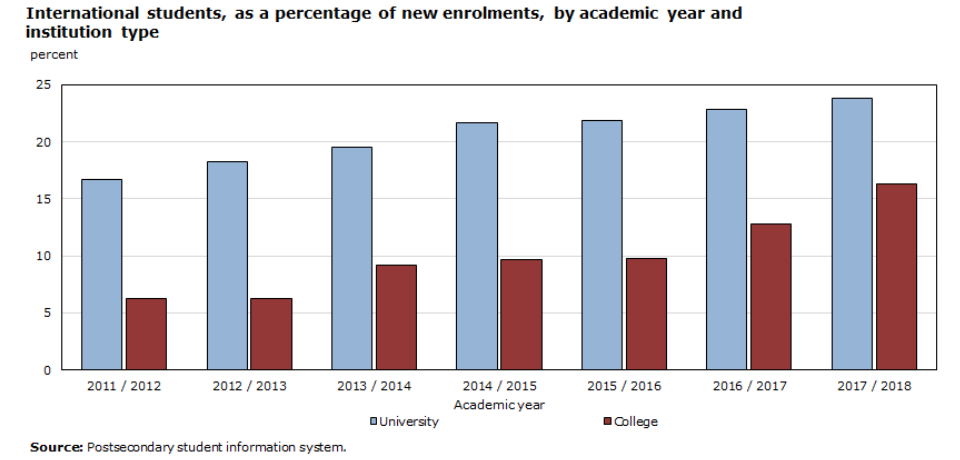One-quarter of Canada’s new university enrolments and 16.3% of new college enrolments were international students in 2017/2018, according to new data – which could spell trouble for the country’s postsecondary sector if prospective international students choose to stay home in the wake of Covid-19.
News and business analysis for Professionals in International Education
Have some pie!
Statistics Canada highlights factors for reduced int’l demand
 International students accounted for 14.7% of total university enrolments in Canada in 2017/2018, up from 8.2% in 2008/2009. Photo: Andre Furtado/ Pexels
International students accounted for 14.7% of total university enrolments in Canada in 2017/2018, up from 8.2% in 2008/2009. Photo: Andre Furtado/ Pexels “If institutions must rely on virtual delivery of courses, some programs may be more affected than others”
In a report that examined international student enrolment in postsecondary education prior to the pandemic, Statistics Canada explained that international enrolments comprise an even larger share of new enrolments than total enrolments.
It revealed that international students accounted for 14.7% of total university enrolments in Canada in 2017/2018, up from 8.2% in 2008/2009, while at college level, this figure rose from 5.2% to 13.2% during the same period.
“[By contrast] almost one-quarter (23.8%) of new university enrolments and 16.3% of new college enrolments were international students in 2017/2018,” the report noted.
Although both prospective and current international students are affected by the pandemic, “prospective students may be more likely to stay home during the pandemic since they have yet to invest in Canadian postsecondary education”, the report continued.
It highlighted that international students pay substantially higher tuition fees than their Canadian-born counterparts and that these fees have helped reduce the gap between “rising operating expenses and stagnant provincial grants over the past decade”.
“Prospective students may be more likely to stay home during the pandemic than current international students”
As a result, continued the report, the share of enrolments in various academic programs is of high relevance at the moment as certain program areas were found to rely heavily on international student enrolment.
Of particular note were programs related to “mathematics, computer and information sciences” where almost one-third (30.8% at college level and 31.6% at university level) of enrolments were revealed to be international in 2017/2018.
At the university level, programs with the highest share of international enrolments included statistics (49.5%), computational science (38.5%), mathematics (37.4%), and applied mathematics (36.3%).
“Certain programs may be less amenable to online delivery than others” the report continued, although programs including education, visual and performing arts, and health-related programs generally did not rank very high with regards to international student enrolment.
However, reliance on international students was “still notable in many of these programs (often over 10%)”.
With regards to key source countries for university enrolments, China topped the list in 11 of the 12 program areas, coming in second in ‘health and related fields’ just behind Saudi Arabia.
One in six (16.4%) of all students in ‘mathematics, computer and information sciences came from China, which accounted for slightly more than half of all international enrolments in this program.
In colleges, India was the top source of international enrolment in most broad program areas, accounting for at least half of all international students in six of the program areas.
As Canadian institutions face uncertainty with regards to whether or not in-person classes can be resumed for the 2020 fall term, they are examining and building plans for all scenarios ranging from partial to fully online learning.
In recent weeks, the Canadian government has brought in measures to assist international students caught in the pandemic crossfire, while individual institutions have introduced millions of dollars in support funds.
Last month, IRCC announced it would accept applications for study permits and post-graduate work permits, while provinces such as Quebec have confirmed that international students who were forced to remain in their home country due to Covid-19 restrictions will be allowed to begin their studies remotely this fall.
However, not all areas of study are equally amenable to online learning, warned the Statistics Canada report.
“If institutions must rely on virtual delivery of courses, some programs may be more affected than others,” it read, particularly students in sciences and engineering programs with on-campus laboratory requirements or off-campus work placements.
“[Additionally] international students may not be willing to risk studying in a different country if they feel that the quality of their education is in question…[and] some students may prefer in-class instruction over online learning, especially if in-class instruction is available in their own country.”
Students may also prefer to be closer to home during the pandemic or simply because of the potential for class cancellations.
According to a recent international prospective student study conducted by Academica Group in partnership with Maple Assist, 10% of students surveyed are no longer planning to enrol in a Canadian institution in fall 2020, while 13% need more time to decide – both groups citing health concerns related to the coronavirus (37%) as one of the key reasons.
“All of these factors may result in reduced international demand for Canadian postsecondary education,” the Statistics Canada report concluded.
But despite the obstacles brought on by the pandemic, the province of Ontario has recorded international student applications at a similar level to last year.
“There’s still a long time between now and September”
Local media reported that overall, 103,426 offers of admission to domestic and international students have been confirmed, compared with 102,289 a year ago.
However, institutions remain cautiously optimistic about the future, with international students who have confirmed an offer of admission at Western University down about 10% compared with last year.
“We feel good about our numbers, but we are also watching them closely,” Western University registrar, Glen Tigert told The Globe and Mail.
“There’s still a long time between now and September.”
Still looking? Find by category:




